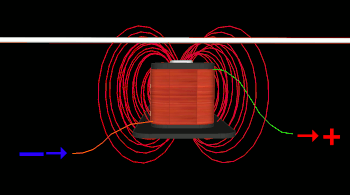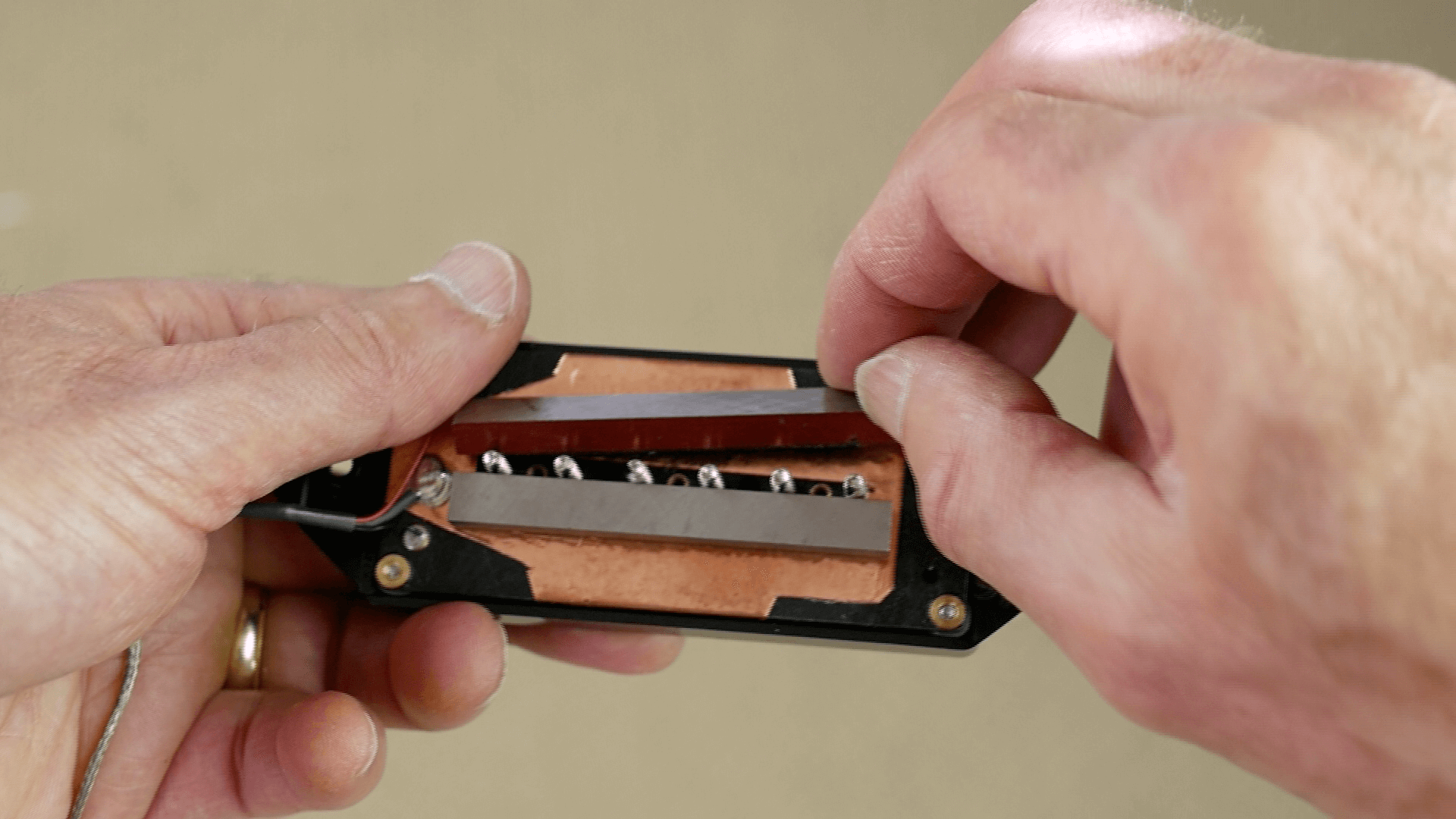Pickup Magnet Comparison
It’s been a long, strange year! I’ve hardly posted at all to my blog. My band is on pandemic hiatus- no gigs since January. I’ve been insanely busy at work. It’s becoming apparent that I only have the bandwidth (or is it the willpower?) to produce one video per year, which I typically finally finish during my vacation at the end of December. So here is my video for 2020- something that I’ve been planning for over 10 years – a controlled comparison of magnet pickup types.
When I bought my Epiphone Riviera P93 (see the first post in this blog, back in 2009), I was immediately disappointed by the dull sound of its pickups and electronics, and that disappointment motivated a massive multi-year electronics learning and renovation project which I’ve documented in my blog posts and YouTube videos.
Back in 2009, I purchased a set of Vintage Vibe Guitars P-90’s to upgrade the Riviera. These pickups make it very easy to swap the bar magnets, so I requested a complete set of their magnet options- AlNiCo II, AlNiCo III, AlNiCo V and Ceramic 8. I had fully intended to do a project comparing the different magnet types back in 2010 or so, but so many other projects and life got in the way. Until now!
Installing the P-90 in my SG
I’ve since sold that Epiphone Riviera, so I used my 2013 Gibson SG for the experiment. While it’s not routed for P-90’s, it has some nice benefits for this experiment. The humbucker is connected to the circuit using a plug, so I can remove it without soldering. And the Steinberger gearless tuners make it relatively easy to take the strings off to swap magnets, then put the exact same strings back on.
I removed the SG’s bridge humbucker and temporarily taped the P-90 in place. I snaked the pickup lead through to the control cavity but I didn’t actually connect it up to the SG’s circuit- I just alligatored in a separate jack, and grounded it to the bridge – so we’ll be hearing the raw pickup sound with no volume or tone knob involvement.
Four Magnet Types
I tested four magnet types- Alnico II, III, V and Ceramic 8. An AlNiCo magnet contains Aluminum, Nickel and Cobalt while the Ceramic or ferrite magnets are composed of iron oxide and strontium carbonate. The different magnet types have different field strengths. AlNiCo III is the weakest. AlNiCo II is slighty stronger. AlNiCo V is about 5 times as strong as those. And Ceramic-8 is stronger still.
I’ve read that the stronger the field, the higher the signal output, and the more aggressive the tone and the sharper the attack. Also, a stronger magnetic field will have more interaction with the string itself (especially if the strings are very close to the pole pieces)- and that magnetic pull on the strings can result in reduced sustain.
So with that in mind, we should expect the AlNiCo III to have the warmest vintage tone with the lowest output and softest attack and longest sustain, while at the other end, the Ceramic 8 should have a modern aggressive tone with highest output and sharpest attack, and maybe the least sustain. We’ll see if we can actually hear these differences in the recordings.
This P-90 Pickup
To change the magnets on this pickup, you just remove the 3 screws on the backplate, then the bar magnets slide right out. The bar magnets must be installed with the correct magnet polarity. Vintage Vibe Guitars marks these magnets with a color on the north side indicating the magnet type – red for AlNiCo V. This pickup has both magnets with the north side facing in to the pole pieces.
The particular P-90 pickup I’m using in the experiment is scatter wound with 8500 turns of 43 gauge magnet wire around the bobbin, with a DC resistance of 9.1k ohms.
How a Pickup Works
Before continuing, it’s worth summarizing how a guitar pick up works and why these different magnet types might have an impact on the sound. Also see the series of articles on my blog written by Pete Biltoft.
The pickup consists of a bobbin, wrapped in a long continuous coil of wire, with the pole pieces running through it. The pole pieces are either rod magnets, as in a tele or strat, or conductive steel rods in contact with bar magnets lower in the assembly, as with this P-90.

The magnetic field from the magnets in the pickup extend out into the space around the pickup, and when a string containing iron or nickel vibrates within that magnetic field, the field will vibrate with the same frequency as the string.
One of the wonders of our universe is that when a magnetic field moves near a coil of wire, an electric current is generated. This is the same principle used in an electric generator. As the guitar string vibrates within the pickup’s magnetic field, the electrons in the coil will oscillate back and forth, inducing an alternating current – which is the guitar signal. The more turns of wire in the coil, the larger this current will be.
Similarly, in microphones- the moving membrane causes a magnet to move over a coil of wire. And in a loudspeaker it’s just the reverse- an alternating current signal in the coil causes the magnet to move, which is attached to a paper cone that vibrates in the air to produce sound.
Here’s a few links, if you’re interested in learning more:
https://en.wikipedia.org/wiki/Electromotive_force
https://en.wikipedia.org/wiki/Electromagnetic_induction
https://www.khanacademy.org/science/in-in-class10th-physics/in-in-magnetic-effects-of-electric-current/electromagnetic-induction/v/electromagnetic-induction-faradays-experiments
https://www.youtube.com/watch?v=bq6IhapfucE
Recording and Helix Setup
For the playing examples, I tried to control everything to be as similar as possible with each example, so the only significant difference is the magnets being used. It was the same pickup body, same pickup position and pole piece height, same strings and string height, same amp and recording settings. The one thing I can’t really control perfectly is my playing- I’m not good enough to turn in the exact same performance each time, but I did my best.
I recorded direct from my Helix over USB, and did no post-processing or level-adjustment on the recordings. This is the simple Helix preset I made for the comparison:
This preset contains three amps and a 4×12 cabinet, through a spring reverb. I used three snapshots to select one amp at a time.

Here are settings for the US Double Nrm (Fender Twin), Essex A30 (VOX AC30) and Brit 2204 (Marshall JCM800) amps:



And here are the settings for the 4×12 Greenback 25 cabinet and Spring reverb:


Conclusions?
I didn’t include a conclusion at the end of the video, because I wanted to leave it up to the viewer/listener to decide. But I’ll share some of my thoughts here:
When I edited the video to place the different magnet type examples side-by-side, I was surprised that in some cases the differences were startling clear, but in others, not so much.
It’s totally subjective, but I generally found the Ceramic 8 to be too harsh and woofy for my taste, while the AlNiCo V generally always felt just about right. What did you think?
Update – Sustain Tests
Update December 20, 2020: in addition to the playing examples, I also recorded some sustain tests, where I just strummed an open E major chord and held until it died out, and then plucked a single note (E at the 5th fret of the B string). I showed a count-up timer overlay in the video:
But in the end, I decided to remove it from the video because it wasn’t particularly conclusive. I think maybe that test really needed a more controlled pluck impulse (to ensure they are all picked with the identical force), but I’d need a robot to do that! Here were the results that I saw:
- AlNiCo III – E major strum, 26 secs. Single note: 9 secs
- AlNiCo II – E major strum, 26 secs. Single note: 8 secs
- AlNiCo V – E major strum, 23 secs. Single note: 12 secs
- Ceramic 8 – E major strum, 27 secs. Single note: 8 secs
And it was super-boring to watch me strum and stand there for 30 seconds each time 🙂 If people are really clamoring to see it, I can post that as a follow-up video.
















January 12, 2021 @ 11:51 am
Wow, that was a lot of work! Thanks! To my ear (I’m 67) listening through a 12” Headrush via an Audiolab, the ceramic was muddier. Preferred the Alinico 2 above the other Alnico strengths, depending on the licks. I’m splitting hairs though 😀
January 12, 2021 @ 12:41 pm
Hey Harry- thanks for the feedback! The ceramic was strange- I thought it sounded wooly and muffled in some cases, and ear-splittingly bright in other cases. Definitely not my cup of tea! 🙂
-John
February 13, 2021 @ 10:53 am
For my uses I preferred the Al3 that half breakup and shimmer on the chords is just right.. the Pearl Jam riff you played de played that very well
February 13, 2021 @ 1:29 pm
Thanks for the feedback. It was neat hearing the differences for sure! I liked all the alnicos for different reasons. I didn’t play any Pearl Jam- (as far as I know!) Let me know which riff you’re referring to, and I’ll tell you what I thought I was playing! 🙂
-John
March 27, 2021 @ 3:21 am
Was a great video : I’d go with the alcino II or the V , but – I think that’s mostly because the cermaic 8 had harsh highs-
and that has alot to do with playing style and how you pick.
the alcinos sounded more pleasing because they smoothened out the playing , I.e your own playing dynamic made less drastic changes to the tone.
What would be interesting to see is how the ceramic 8 would perform if the pickup Hight is lowered – maybe lowering it would roll off some off the harshness but would give a sound that is clear and retains alot of highs.
Please make a comparison , this time playing around with the pickup hight.
Btw on the JCM everything sounded pretty much the same.
March 27, 2021 @ 9:49 am
Hey- thanks for the feedback. I’m sure those ceramics would work well for some playing styles- but not mine! Unfortunately I don’t have the pickups anymore so can’t do anymore comparisons.
-John